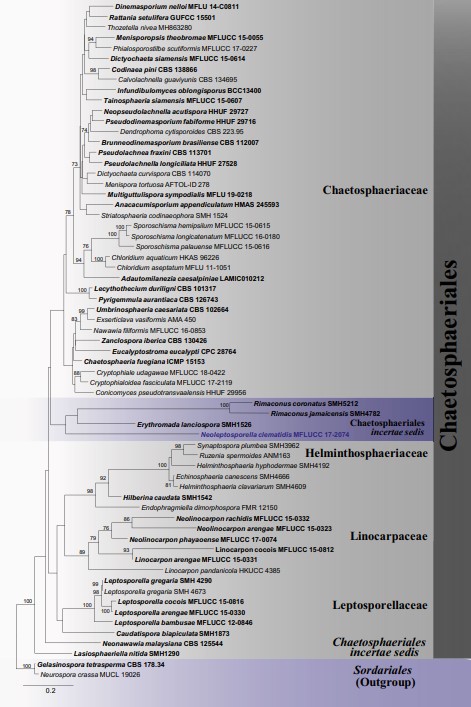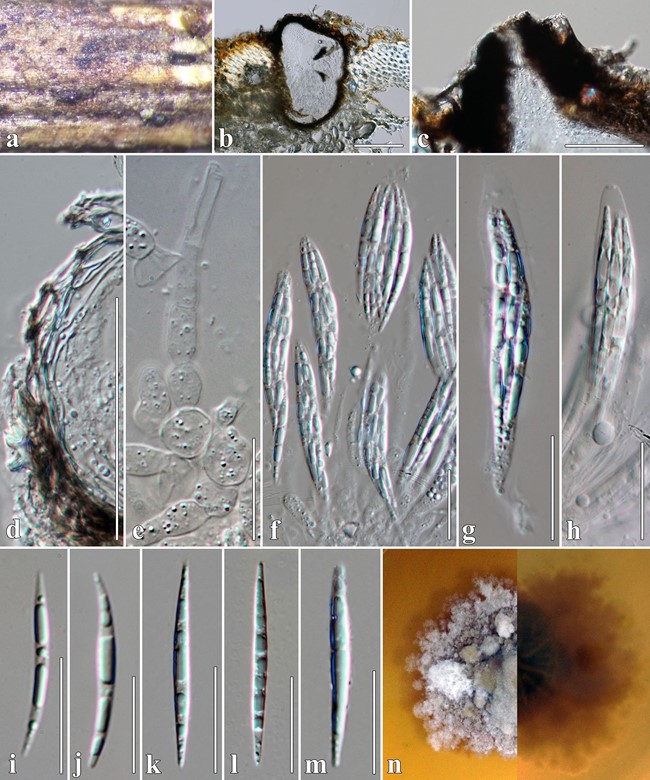Neoleptosporella clematidis Phukhams., Konta & K.D. Hyde, sp. nov.
MycoBank number: MB 557060; Index Fungorum number: IF 557060; Facesoffungi number: FoF 07246, Fig. 94.
Etymology: named after the host genus, Clematis.
Holotype: MFLU 17–1482.
Saprobic on dead branches of Clematis subumbellata. Sexual morph: Ascomata (including neck) 150–200 × 100–120 μm (x̄ = 170 × 115 μm, n = 10), solitary, immersed, only black shiny ostioles visible, immersed beneath small clypeus, appearing as a disc around the neck, coriaceous, subglobose to depressed globose, as raised blister-like areas, ostiolate. Ostioles central, 60 × 55 μm, carbonaceous, black, filled with periphyses. Peridium 5–10(–22) μm wide, outer cells merging with the host epidermal cells, composed of 3–4(–8 at apex) layers of dark brown to black cells of textura angularis. Paraphyses of numerous, 6–16 µm wide ( x̄ = 4 μm, n = 10), hyaline, branched, septate, longer than asci. Asci 60–86 × 6–10 μm ( x̄x̄ = 75 × 8 μm, n = 30), 8-spored, unitunicate, broad cylindrical, long-pedicel- late, with a J-, wedge-shaped, subapical ring. Ascospores 32–50 × 2–4 μm (x̄ = 38 × 3 μm, n = 50), filiform, straight or curved, C-shaped or sigmoid, aseptate, acute ends, without polar appendages, smooth-walled, with minute guttules in each cell. Asexual morph: Undetermined.
Culture characters: Colonies on MEA reaching 30 mm diam. after 4 weeks at 25 °C, Culture from above, cream, radiating, wrinkled, folded in the middle, dense, lobate, flat- tened, umbonate, edge irregular, fluffy; reverse black in the middle and cream at the edge, radially striate with lobate edge.
Material examined: Thailand, Chiang Rai Province, on dead stems of Clematis subumbellata, 20 March 2017, C. Phukhamsakda, CMTH18 (MFLU 17–1482, holotype); ex- type living culture, MFLUCC 17–2074.
Host: Clematis subumbellata—(This study).
Distribution: Thailand—(This study).
GenBank accession numbers: LSU: MN628626; tef1: MN629286; rpb2: MN628628.
Notes: In the phylogenetic analysis, Neoleptosporella clematidis (strain MFLUCC 17–2074) formed a distinct clade from other Leptosporella species (Fig. 93). The asexual morph of our taxon was not obtained from culture. In a BLASTn search of GenBank, the closest match of the LSU sequence of MFLUCC 17–2074 is Leptosporella bambusae with 85% similarity to strain MFLUCC 12–0846 (NG_059674). This is the first record of Leptosporellaceae on Clematis (Fig. 94). Isolate MFLUCC 17–2074 was evaluated for bioactive secondary metabolite production. The strain inhibits the growth of Bacillus subtillis but not at significant values (data not shown).

Fig. 93 The best scoring RAxML tree with a final likelihood value of − 19621.398134 of LSU and ITS sequence data. The topology and clade stability of the combined gene analyses was compared to the single gene analyses. Sixty-five strains were included in the combined genes sequence analyses which comprised 1655 charac- ters (1060 characters for LSU and 595 characters for ITS, including gap regions). Thistree includes selected taxa of Chaetosphaeriales and rooted with Gelasinospora tetrasperma (CBS 178.34) and Neu- rospora crassa (MUCL 19026) in Sordariales. The matrix had 990 distinct alignment patterns, with 30.05% of undetermined characters and gaps. Estimated base frequencies were as follows; A = 0.230333, C = 0.267483, G = 0.312066, T = 0.190118; substitution rates AC = 1.241984, AG = 1.768569, AT = 1.330285, CG = 1.057213, CT = 5.757832, GT = 1.000000; gamma distribution shape parameter α = 0.462145. Ex-type strains are in bold black and the species deter- mined in this study is indicated in blue. Bootstrap values (over 70% BT) from maximum likelihood are given at the nodes

Fig. 94 Neoleptosporella clematidis (MFLU 17–1482, holotype). a Appearance of ascomata on Clematis subumbellata. b Vertical section through ascoma. c Ostiole. d Peridium. e Paraphyses. f–h Asci (h asci in 5% KOH presenting a J-reaction of apical ring, wedge- shaped). i–m Ascospores. n Culture characteristics on MEA. Scale bars: b = 100 μm, c, d = 50 μm, e–h = 20 μm, i–m = 10 μm
